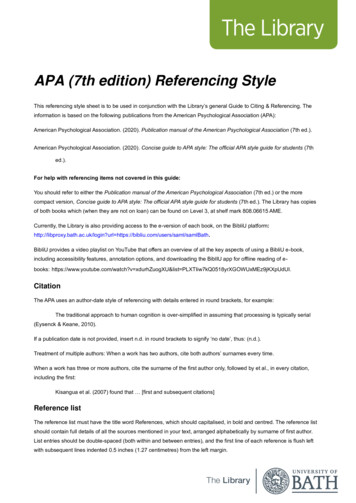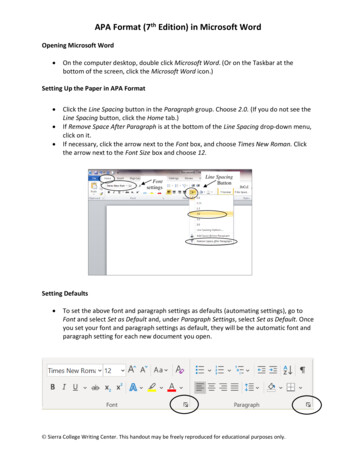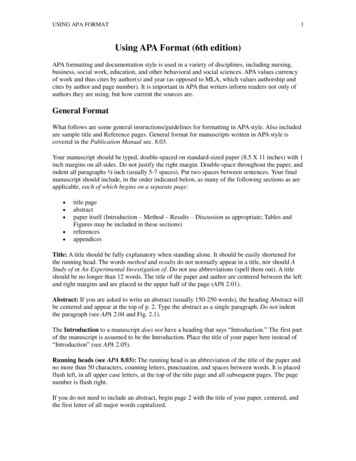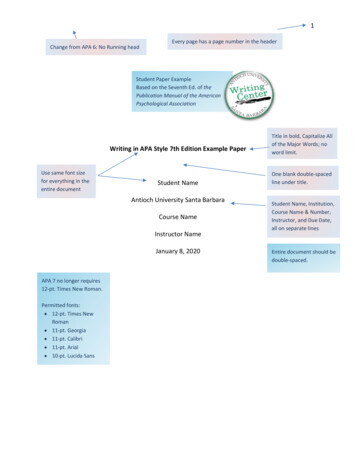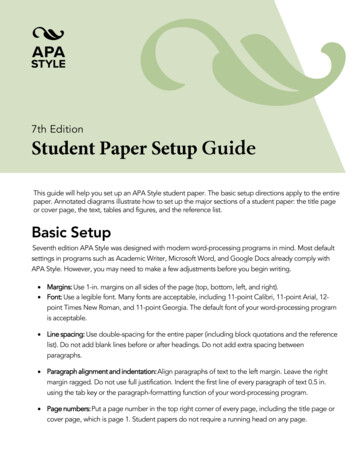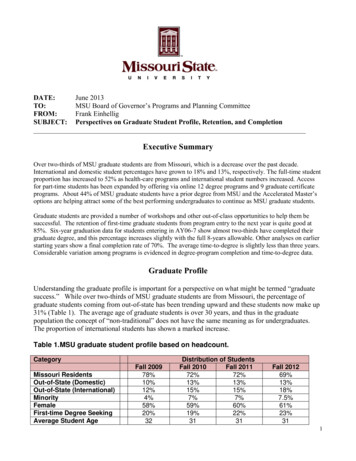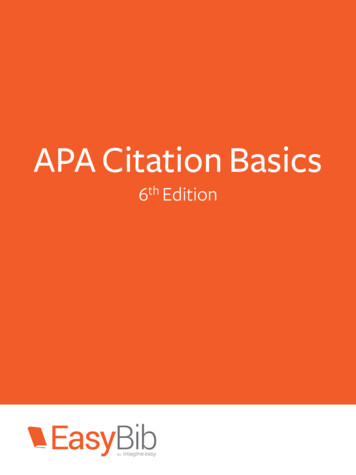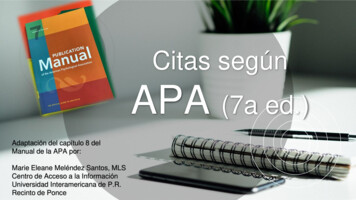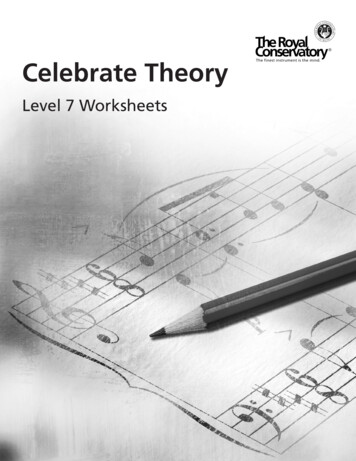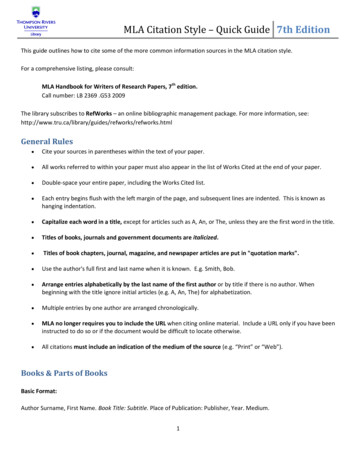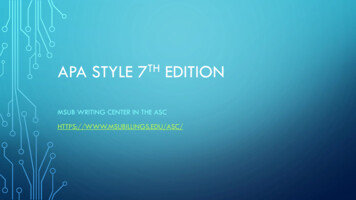
Transcription
APA STYLETH7EDITIONMSUB WRITING CENTER IN THE ASCHTTPS://WWW.MSUBILLINGS.EDU/ASC/
WHAT IS APA?The American Psychological Association (APA) “style provides a foundation for effectivescholarly communication because it helps authors present their ideas in a clear, concise, andorganized manner” (APA, 2020, p. xvii).Disciplines that Use APA:APA regulates:BusinessStyle and languageHealth SciencesDocument formatSciencesIn-text citationsSocial SciencesReferences
FORMAT 1” margins on all sides of document (default setting) Student papers need only to include a page number in the upper right-hand cornerof every page (title page is page 1) Use a common, readable font throughout Recommended: Calibri (11 pt.) or Times New Roman (12 pt.) Double spacing throughout (including title and references pages)
APA PAPER SECTIONS Most student papers now do not need an abstract. (Check with yourinstructor.)Title PageAbstractIntroductionLiterature ReviewMethodsResults/FindingsDiscussionReferences
TITLE PAGEHeader (student paper):Page number in upper righthand cornerTitle Page is page 1Title: Centered, BoldAuthor’s Information: Centered,Double-Spaced, includesName, University, Course,Faculty, Date
Level1HEADINGSHeading FormatCentered, Bold, Title Case HeadingText begins as a new paragraph.2Flush Left, Bold, Title Case HeadingText begins as a new paragraph.3Flush Left, Bold Italic, Title Case HeadingText begins as a new paragraph.4Indented, Bold, Title Case Heading, Ending With a Period. Textbegins on the same line and continues as a regular paragraph.5Indented, Bold Italic, Title Case Heading, Ending With a Period. Textbegins on the same line and continues as a regular paragraph.
TEXT Header includes pagenumber Title is Centered, Bold, TitleCase Text is left-justified anddouble-spaced Use a readable fontthroughout No creative effects Follow the headingguidelines to label sections
STYLE GUIDELINES Use clear, concise language; avoid contractions and colloquialisms Numerals under 10 should be spelled out; 10 and above expressed as a number Past tense verbs should be used to refer to events that occurred at a specific point in the past (suchas a researcher’s work) Use “I” in place of editorial “we” Do not use “he” or “she” as a generic pronoun; it is acceptable to use “they” or rephrase thesentence Avoid biased language that reveals sex, gender, race, disability, socio-economic status
IN-TEXT CITATIONS
OVERVIEW Credit ideas, texts, research and media that have directly influenced your work Author-date citation system (corresponds to the first word of the references entry) Parenthetical:This is an example of a parenthetical in-text citation (Karas, 2020). Narrative:Karas (2020) offered an example of a narrative in-text citation.
PARAPHRASES Paraphrases state the ideas of another in the author’s own words. APA prioritizes paraphrasing over quoting Published authors primarily paraphrase, and students should learn to emulate this style Use the author-date citation system to attribute paraphrased ideasParaphrases allow the author to condense information and synthesize ideasfrom multiple sources (American Psychological Association [APA], 2020).
Quote sparingly. Reserve quotes for vivid, impactfullanguageDIRECTQUOTESFor direct quotes of fewer than 40 words, use the authordate citation system, include a page number (p. or pp.) orother locator, and incorporate the quote into the paragraph.Narrative: According to the APA (2020), “a direct quotationreproduces words verbatim from another work” (p. 270).Parenthetical: “A direct quotation reproduces wordsverbatim from another work” (APA, 2020, p. 270).
DIRECT QUOTES Block quotes (of 40 words or more): Do not use quotation marks. Start the quotation on a newline indented .5 in from the left margin. Double space the block quotation. The parentheticalreference goes after the final period.Researchers have studied how people talk to themselves:Inner speech is a paradoxical phenomenon. It is an experience that is central to manypeople’s every day lives, and yet it presents considerable challenges to any effort tostudy it scientifically. Nevertheless, a wide range of methodologies and approacheshave combined to shed light on the subjective experience of inner speech and itscognitive and neural underpinnings. (Alderson-Day & Fernyhough, 2015, p. 957)
UN-PAGINATED SOURCES Provide a heading or section name Use an abbreviated name in quotes if the section name is too long(Gecht-Silver & Duncombe, 2015, Osteoarthritis section). Provide a paragraph number (count manually if not numbered)(Chamberlin, 2014, para. 1). Provide a timestamp for beginning of material quoted from audio/visual sources(Cuddy, 2012, 2:12)
MULTIPLE AUTHORS One or two authors: include the names of both authors in every in-textcitationNarrative: Jones and Kim (2019) reported that Parenthetical: (Jones & Kim, 2019). Three or more authors: include the name of only the first author plus “etal.” in every citation, including the first (unless this would create ambiguity)Narrative: Jones et al. (2019) found that the effects of Parenthetical: (Jones et al., 2019).
UNKNOWN AUTHORORGANIZATION AS AUTHOR Unknown author: include the title and year of publicationNarrative: In 2015, “Tech Seeds” reported (p. 30)Parenthetical: (“Tech Seeds,” 2015, p. 30). Organization as author: name the organization and year of publicationAccording to the International Society for Technology in Education (2016), First citation: (Food and Drug Administration [FDA], 2012)Later citations: (FDA, 2012)
TWO OR MORE WORKS IN THE SAMEPARENTHETICAL REFERENCE When citing multiple works in the same parenthetical reference, place thecitations in alphabetical order, separating them with semicolons.Though procedures differ across institutional contexts, a traditional model ofacademic probation relies on student-initiated efforts to improve academicstanding within a passive institutional framework (James & Graham, 2010;Lindo et al., 2008).
REFERENCES
FORMAT“References” centeredand boldedEntries arranged inalphabetical order withhanging indent
IDENTIFY THE SOURCE TYPE To determine the format to follow, ask: Author: Who is responsible for this work?Date: When was the work published?Title: What is this work called?Source: where can I retrieve this work? What to do when one or more elements are missing: eferences/missing-information
Punctuation: Put a period in between reference elements Use commas to separate parts of an element Capitalize the letter of titles, subtitles (after the : ), and proper names Author: the person or group responsible for creating, writing,REFERENCEELEMENTSor editing the content of a work Date: date of publication Title: the title of the work being cited Stand-alone titles: book, journal, website, report Part of a greater whole: article, chapter Source: where readers can retrieve the work cited (journal,website, publisher) URLs and DOIs: present both as hyperlinks (notnecessary to include “Retrieved from”)
CITING A BOOK Authored book (with multiple editions, with or without a DOI)Author, A. A., & Author, B. B. (year). Title of book (2nd ed.). Publisher name.DOIBurgess, R. (2019). Rethinking global health: Frameworks of power.Routledge.Brown, L. S. (2018). Feminist therapy (2nd ed.). American PsychologicalAssociation. https://doi.org/10.1037/0000092-000
CITING A JOURNAL ARTICLE Article with a DOI or database URL (if given both, choose the DOI)Author, A. A. & Author, B. B. (year). Title: Subtitle. Journal Title, Volume(issue), p#.DOI.McCauley, S. M., & Christiansen, M. H. (2019). Language learning as languageuse: A cross-linguistic model of child language development.Psychological Review, 126(1), 1-15. https://doi.org/10.1037/rev0000126
RESOURCES Recommended: The APA Guide (7th Edition) A writing manual such as the Bedford Guide for College Writers (latest edition) Free Electronic Resources: Purdue OWL: https://owl.purdue.edu/owl/purdue owl.html Excelsior OWL: https://owl.excelsior.edu/ APA Style Blog: https://apastyle.apa.org/blog/
PRESENTATION REFERENCESAmerican Psychological Association. (2020). Publication manual of the AmericanPsychological Association: The official guide to APA style (7th ed). AmericanPsychological Association.American Psychological Association. (2020). Sample elines/paper-format/samplepapers
FORMAT 1” margins on all sides of document (default setting) Student papers need only to include a page number in the upper right-hand corner of every page (title page is page 1) Use a common, readable font throughout Recommended: Calibri (11 pt.) or Times New Roman (12 pt.) Double
